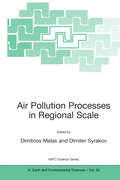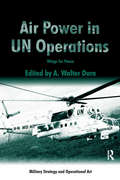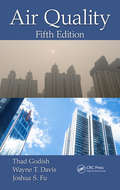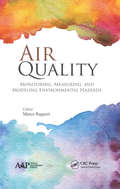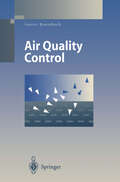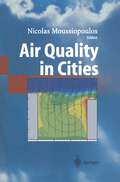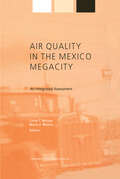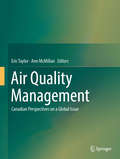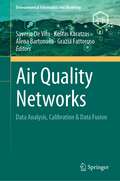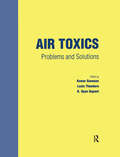- Table View
- List View
Air Pollution Prevention and Control: Bioreactors and Bioenergy
by Christian Kennes Maria C. VeigaOver the past two decades, the use of microbes to remove pollutants from contaminated air streams has become a widely accepted and efficient alternative to the classical physical and chemical treatment technologies. This book focuses on biotechnological alternatives, looking at both the optimization of bioreactors and the development of cleaner biofuels. It is the first reference work to give a broad overview of bioprocesses for the mitigation of air pollution. Essential reading for researchers and students in environmental engineering, biotechnology, and applied microbiology, and industrial and governmental researchers.
Air Pollution Prevention and Control: Bioreactors and Bioenergy
by Christian Kennes Maria C. VeigaOver the past two decades, the use of microbes to remove pollutants from contaminated air streams has become a widely accepted and efficient alternative to the classical physical and chemical treatment technologies. This book focuses on biotechnological alternatives, looking at both the optimization of bioreactors and the development of cleaner biofuels. It is the first reference work to give a broad overview of bioprocesses for the mitigation of air pollution. Essential reading for researchers and students in environmental engineering, biotechnology, and applied microbiology, and industrial and governmental researchers.
Air Pollution Processes in Regional Scale (NATO Science Series: IV: #30)
by Dimitrios Melas Dimiter SyrakovAn understanding of long-range transport of air pollutants in the atmosphere requires a knowledge of the relevant atmospheric dynamic and chemical processes active at the regional scale as well as the temporal and spatial distribution of emissions. Numerical modeling is the most efficient way to determine the atmospheric transport, photochemistry and deposition pathways. The book therefore discusses the physical and chemical processes that determine regional air pollution and presents the relevant modeling techniques to describe the different atmospheric processes that are active at that scale.
Air Power in UN Operations: Wings for Peace (Military Strategy and Operational Art)
by A. Walter DornAir power for warfighting is a story that's been told many times. Air power for peacekeeping and UN enforcement is a story that desperately needs to be told. For the first-time, this volume covers the fascinating range of aerial peace functions. In rich detail it describes: aircraft transporting vital supplies to UN peacekeepers and massive amounts of humanitarian aid to war-affected populations; aircraft serving as the 'eyes in sky' to keep watch for the world organization; and combat aircraft enforcing the peace. Rich poignant case studies illuminate the past and present use of UN air power, pointing the way for the future. This book impressively fills the large gap in the current literature on peace operations, on the United Nations and on air power generally.
Air Power in UN Operations: Wings for Peace (Military Strategy and Operational Art)
by A. Walter DornAir power for warfighting is a story that's been told many times. Air power for peacekeeping and UN enforcement is a story that desperately needs to be told. For the first-time, this volume covers the fascinating range of aerial peace functions. In rich detail it describes: aircraft transporting vital supplies to UN peacekeepers and massive amounts of humanitarian aid to war-affected populations; aircraft serving as the 'eyes in sky' to keep watch for the world organization; and combat aircraft enforcing the peace. Rich poignant case studies illuminate the past and present use of UN air power, pointing the way for the future. This book impressively fills the large gap in the current literature on peace operations, on the United Nations and on air power generally.
Air Purifier: Property, Assessment and Applications
by Zhonglin XuThis book discusses the development, types and application principles of portable air purifiers in China. It analyzes the theoretical characteristics of air purifiers under various operational conditions, and points out that the term “Clean Air Delivery Rate” cannot be used to precisely reflect the problems that occur under various operational conditions. By comparing theoretical and measured data, it highlights the mainfeatures of air purifiers and key points in the design process for different applications. Calculation methods for the indoor particle concentration and the self-purification time are also provided. The book describes the conditions for window opening in smog and for selecting air purifiers, and proposes a newmethod for improvingtheir measurement. In closing, it includes a new assessment index.
Air Quality
by Thad Godish Wayne T. Davis Joshua S. FuThe fifth edition of a bestseller, Air Quality provides students with a comprehensive overview of air quality, the science that continues to provide a better understanding of atmospheric chemistry and its effects on public health and the environment, and the regulatory and technological management practices employed in achieving air quality goals.
Air Quality: Monitoring, Measuring, and Modeling Environmental Hazards
by Marco RagazziThis title includes a number of Open Access chapters. This new compendium provides a nuanced look at monitoring, measuring, and modeling air quality pollution in conjunction with its effects on public health and the environment. Air pollution has been proven to be a major environmental risk to health. Protecting and improving air quality requires knowledge about the types and levels of pollutants being emitted. It also requires the best possible measurement and monitoring capabilities. The chapters in this volume serve as a foundation for monitoring, measuring, and modeling air pollution.
Air Quality: Monitoring, Measuring, and Modeling Environmental Hazards
by Marco RagazziThis title includes a number of Open Access chapters. This new compendium provides a nuanced look at monitoring, measuring, and modeling air quality pollution in conjunction with its effects on public health and the environment. Air pollution has been proven to be a major environmental risk to health. Protecting and improving air quality requires knowledge about the types and levels of pollutants being emitted. It also requires the best possible measurement and monitoring capabilities. The chapters in this volume serve as a foundation for monitoring, measuring, and modeling air pollution.
Air Quality and Human Health
by Markus Hecker Pratap Kumar Padhy Soumya Niyogi Pulak Kumar PatraThe book is one of the outcomes of the SPARC (Scheme for Promotion of Academic and Research Collaboration) project titled "Fine particulates matters in the air environment and their cancer risks in human beings," sponsored by MHRD (now MoE), Govt. of India. The editors of the book are PIs and Co-PIs of the said project. The text deliberates on air pollution's health risks with contributions from well-known experts from diverse research fields (environmental science, toxicology, geology, public health science, biology, physics, chemistry, and geospatial technology). It explores it its control and mitigation strategies. The book provides an up-to-date overview of the modern methods and tools used in air quality monitoring and human health risk assessment. Case studies from different global settings offer invaluable insights into air pollution-related regional health issues. It addresses all aspects of air quality, covering indoor-outdoor air pollution, gaseous and particulate pollutants; characterization of source and pathways of air pollutants; and the modeling and assessing of health risks (respiratory, epidemiological, and toxicological) with regional and global perspectives. It also addresses air quality management issues. The lucid explanation of the role of oxidative stress mechanisms and molecular biomarkers (genomics, proteomics) may be considered as inputs into the development of cancer therapeutics. Along with providing a scientific basis for air pollution, this book will help readers appreciate the environmental determinants of public health and apply research evidence to improve the quality of life. It also delineates future research initiatives and policy actions needed to protect human health from air pollution, locally and globally. The book will be of great educational value and help for consultation and teaching.
Air Quality Control: Formation and Sources, Dispersion, Characteristics and Impact of Air Pollutants — Measuring Methods, Techniques for Reduction of Emissions and Regulations for Air Quality Control (Environmental Science and Engineering)
by G. BaumbachAir quality and air pollution control are tasks of international concern as, for one, air pollutants do not refrain from crossing borders and, for another, industrial plants and motor vehicles which emit air pollutants are in widespread use today. In a number of the world's expanding cities smog situations are a frequent occurrence due to the number and emission-intensity of air pollution sources. Polluted air causes annoy ances and can, when it occurs in high concentrations in these cities, constitute a seri ous health hazard. How important clean air is to life becomes apparent when consid ering the fact that humans can do without food for up to 40 days, without air, how ever, only a few minutes. The first step towards improving the air quality situation is the awareness that a sound environment is as much to be aspired for as the development of new tech nologies improving the standard of living. Technical progress should be judged es pecially by how environmentally benign, clean and noiseless its products are. Of these elements, clean air is of special concern to me. I hope that this book will awaken more interest in this matter and that it will lead to new impulses. Due to the increasing complexity of today's machinery and industrial processes science and technology can no longer do without highly specialized design engineers and opera tors. Environmental processes, however, are highly interdependent and interlinked.
Air Quality in Cities
by Nicolas MoussiopoulosUrban areas are major sources of air pollution. Pollutant emissions affecting air quality in cities are considered to have adverse consequences for human health. Public and government concern about environmental issues arising from urban air pollution has increased over the last decades. The urban air pollution problem is widespread throughout the world and it is important to find ways of eliminating or at least reducing the risks for human health. The fundamentals of the physical and chemical processes occurring during air pollutant transport in the atmosphere are nowadays understood to a large extent. In particular, modelling of such processes has experienced a remarkable growth in the last decades. Monitoring capabilities have also improved markedly in the most urban areas around the world. However, neither modelling nor monitoring can solve urban air pollution problems, as they are only a first step in improving useful information for future regulations. The defining of efficient control strategies can not be achieved without a clear knowledge of the complete pollution process, i.e. emission, atmospheric transport and transformation, and deposition at the receptor. Improving our ability to establish valid urban scale source-receptor relation ships has been the objective of SA TURN, one of the 14 subprojects of EURO TRAC-2. Similar to the other subprojects of this co-ordinated environmental pro ject within the EUREKA initiative, SA TURN brought together international groups of scientists to work on problems directly related to atmospheric chemistry and physics. The present volume summarises the scientific results of SATURN.
Air Quality in the Mexico Megacity: An Integrated Assessment (Alliance for Global Sustainability Bookseries #2)
by Mario J. Molina Luisa T. MolinaIn this book, experts in atmospheric sciences, human health, economics, social and political sciences contribute to an integrated assessment of the complex elements needed to structure air quality policy in the 21st century. The analysis is developed through a case study of the Mexico City Metropolitan Area - one of the world's largest megacities in which air pollution grew unchecked for decades. The international research team is led by Luisa T. and Mario J. Molina, Nobel Laureate in Chemistry. Improvements in Mexico City's air quality in the last decade testifies to the power of determined and enlightened policy making, and throws into relief the tough problems that remain to be solved.The volume's first six chapters, including the contributions of over 50 distinguished scholars from Mexico and the US, outline the fundamental areas of knowledge policy makers must accommodate. The message is that only good science and well-chosen technologies can direct the way to corrective regulatory measures; but without strong commitment from government, no amount of science or technology can help.
Air Quality Integrated Assessment: A European Perspective (SpringerBriefs in Applied Sciences and Technology)
by Giorgio Guariso Marialuisa VoltaThis book is open access under a CC BY 4.0 license.This book reports on the results of an extended survey conducted across Europe within the framework of the APPRAISAL FP7 project to determine the extent to which an integrated assessment approach to air quality is being adopted, on the one hand, by regional and local authorities to develop air quality plans and, on the other, by researchers. Following a detailed analysis of the role and structure of the components of an integrated assessment study, the results of the survey are considered from a variety of perspectives. Above all, the book discusses the new light the survey sheds on emission abatement policies and measures planned at regional and local scales, and on their synergies/trade-offs with measures implemented at the national scale. Detailed consideration is given to the currently available modeling methodologies for identifying emission sources, assessing the effectiveness of emission reduction measures, and evaluating the impacts of emission abatement measures on human health. Current strengths and weaknesses revealed by the survey are explored, and the application of an integrated assessment tool in two case studies (in Brussels and Porto) is discussed. The book will appeal to all those interested in the use of integrated assessment in connection with the sources, effects and control of air pollution.
Air Quality Management: Canadian Perspectives on a Global Issue
by Eric Taylor Ann McMillanThis book provides a wide overview of the issues related to managing of air quality in Canada. Learn about the air issues that have caused impacts to ecosystems or human health and hence been targeted to be managed. Discover how Canada’s national governance involving a federal government along with provincial and territorial governments impacts the air quality management process. Understand how Canadians manage their air quality in context with the USA, their largest and closest neighbour. Benefit from the experience of 43 of Canada’s most experienced air quality management professionals who share their insights into the state of air quality in Canada today, how it is managed, as well as giving a glimpse into the future.
Air Quality Networks: Data Analysis, Calibration & Data Fusion (Environmental Informatics and Modeling)
by Saverio De Vito Kostas Karatzas Alena Bartonova Grazia FattorusoThis volume offers expert contributions proposing new and recently set scientific standards for smart air quality (AQ) networks data processing, along with results obtained during field deployments of pervasive and mobile systems. The book is divided into 5 main sections; 1) future air quality networks, 2) general data processing techniques, 3) field deployments performances, 4) special applications, and 5) cooperative and regulatory efforts. The authors offer different sources of data for the production of trustworthy insights, including spatio-temporal predictive AQ maps meant to boost citizen awareness, and informed participation in remediation and prevention policies. Readers will learn about the best and most up-to-date practices for measuring and assessing air quality, while also learning about current regulatory statuses regarding air quality technology design and implementation. The book will be of interest to air quality regulatory agencies, citizen science groups, city authorities, and researchers and students working with air quality sensors and geostatistics.
Air-sea rescue helicopter (Large Print)
by RnibThe helicopter is viewed from the side with only one of its main wheels showing at the lower centre of the page, and with a tail wheel to its right. There is a locator dot shown, which will be at the top left of the page when the image is the right way up. The cockpit at the front is on the left of the page and the tail on the right. The long rotor blades stretch from the left of the page to the right, above the helicopter body. On the left of the body there are three cockpit windows, up from these is the engine grill. Up from the main wheel one of the helicopter's floats is shown and two more windows. To the right of these is the open hatch through which people are winched during rescue missions. Right from the hatch is another window. Above the hatch and single window is the radar dome on the top edge of the helicopter. At the far right of the page is the six bladed tail rotor.
Air-sea rescue helicopter (UEB Contracted)
by RnibThe helicopter is viewed from the side with only one of its main wheels showing at the lower centre of the page, and with a tail wheel to its right. There is a locator dot shown, which will be at the top left of the page when the image is the right way up. The cockpit at the front is on the left of the page and the tail on the right. The long rotor blades stretch from the left of the page to the right, above the helicopter body. On the left of the body there are three cockpit windows, up from these is the engine grill. Up from the main wheel one of the helicopter's floats is shown and two more windows. To the right of these is the open hatch through which people are winched during rescue missions. Right from the hatch is another window. Above the hatch and single window is the radar dome on the top edge of the helicopter. At the far right of the page is the six bladed tail rotor.
Air-sea rescue helicopter (UEB Uncontracted)
by RnibThe helicopter is viewed from the side with only one of its main wheels showing at the lower centre of the page, and with a tail wheel to its right. There is a locator dot shown, which will be at the top left of the page when the image is the right way up. The cockpit at the front is on the left of the page and the tail on the right. The long rotor blades stretch from the left of the page to the right, above the helicopter body. On the left of the body there are three cockpit windows, up from these is the engine grill. Up from the main wheel one of the helicopter's floats is shown and two more windows. To the right of these is the open hatch through which people are winched during rescue missions. Right from the hatch is another window. Above the hatch and single window is the radar dome on the top edge of the helicopter. At the far right of the page is the six bladed tail rotor.
The Air Spora: A manual for catching and identifying airborne biological particles
by Maureen E. Lacey Jonathan S. WestThis is an illustrated guide to trapping, identifying and quantifying airborne biological particles such as fungus, plant spores and pollen. Including a comprehensive review of what is in the air and detailing the historical development of theories leading to modern aerobiology, the book explains the fundamental processes behind airborne dispersal and techniques used to sample, identify and quantify biological particles. Includes photographs and 9 colour reproductions of paintings of airborne particles.
Air-Stable Inverted Organic Light-Emitting Diodes (SpringerBriefs in Applied Sciences and Technology)
by Katsuyuki Morii Hirohiko FukagawaThis concise volume provides an introduction to the working principles, design, and construction of air-stable inverted organic light-emitting diodes (OLEDs), which lead to the realization of practical flexible electronics. The first part of the book reviews the history of the three generations of inverted OLEDs: hybrid organic inorganic light-emitting diodes (HOILEDs), metal oxides and organic electron injection layer, describing the materials, fabrication techniques, device structure, applications, and technological challenges involved in each case. The second part of the book focuses on the carrier injection mechanism in OLEDs.The book will be of interest to students and researchers working on organic optoelectronics.
Air Toxics: Problems and Solutions
by Kumar GanesanThis timely new workbook is the result of a year-long effort by a group of university professors who first met at Montana Tech during the summer of 1994 for a college faculty workshop. The workshop was funded by the National Science Foundation's support for those faculty developing courses in the newly emerging field of air toxics. Part I of the book contains over 100 problems dealing with a variety of topics in this area. Part II provides detailed solutions. The problems and solutions provided will become a useful resource for the training of engineers and scientists who are or soon will be working in the field.
Air Toxics: Problems and Solutions
by Kumar GanesanThis timely new workbook is the result of a year-long effort by a group of university professors who first met at Montana Tech during the summer of 1994 for a college faculty workshop. The workshop was funded by the National Science Foundation's support for those faculty developing courses in the newly emerging field of air toxics. Part I of the book contains over 100 problems dealing with a variety of topics in this area. Part II provides detailed solutions. The problems and solutions provided will become a useful resource for the training of engineers and scientists who are or soon will be working in the field.
Air Traffic Control Automated Systems (Springer Aerospace Technology)
by Bestugin A.R. Eshenko A.A. Filin A.D. Plyasovskikh A.P. Shatrakov A.Y. Shatrakov Y.G.This book highlights operation principles for Air Traffic Control Automated Systems (ATCAS), new scientific directions in design and application of dispatching training simulators and parameters of ATCAS radio equipment items for aircraft positioning. This book is designed for specialists in air traffic control and navigation at a professional and scientific level. The following topics are also included in this book: personnel actions in emergency, including such unforeseen circumstances as communication failure, airplane wandering off course, unrecognized aircraft appearance in the air traffic service zone, aerial target interception, fuel draining, airborne collision avoidance system (ACAS) alarm, emergency stacking and volcanic ash cloud straight ahead.
Air, Water and Soil Quality Modelling for Risk and Impact Assessment (Nato Security through Science Series C:)
by Adolf Ebel Teimuraz DavitashviliThis book contains the proceedings of the NATO Advanced Research Workshop on Air, Water and Soil Quality Modelling for Risk and Impact Assessment. The aim of the workshop was to further joint environmental compartment modelling and applications of control theory to environmental management. It provides an overview of ongoing research in this field regarding assessment of environmental risks and impacts.

